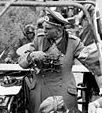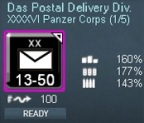BletchleyGeek
Posts: 4713
Joined: 11/26/2009
From: Living in the fair city of Melbourne, Australia
Status: offline

|
quote:
ORIGINAL: Keke
quote:
ORIGINAL: herwin
The mesh (time-space ratio) scale is almost the same as OCS, which is the best manual simulation of the operational level available. The stacking is a bit off--a corps attack frontage was about 8 kilometres, but that might not be that important, particularly as two hexes can concentrate on one.
That brings up a question: If there are superb boardgame designs out there, why not computerize them to a cat free environment? Instead we got all of these fancy looking operational games, with superbly detailed TOEs, that ultimately produce just horse manure.
I don't read herwin's remark as a criticism of WiTE, or computer wargames in general. Both boardgames and computer wargames have bugs either on the rules or the programming, which mediate our appreciation of the work behind them. I don't know why The Gamers - OCS authors - haven't considered a computer adaptation of their OCS or TCS systems, to be honest, but probably the issue has been raised more than once on consimworld or other forums.
Regarding detailed TOE's. A coarse grained 1:1 modeling of unit elements doesn't really guarantee a good simulation. You need also a good simulation engine that effectively uses all that info - rules abstracting combat, supply, etc. - so that it the computations required don't take hours of CPU time and one gets likely outcomes from the simulation.
I sincerely think that WiTE is the closest thing an OCS fan can get on a computer. For this I thank the devs and testers: this is a wonderful product. "Wonderful" doesn't mean "perfect", but WiTE certainly raises the bar.
The perception some have had with WiTE being more a "game" than a simulation has several causes, many of them related to bugs on either the rules or the implementation of replacements mechanics. Operational attrition - due to movement - has been laughable until 1.04, where several changes have been implemented that should partially model the staggering, ebb and flow of operational war that OCS captures so well. These changes perhaps could possibly be complemented with other that explicitly link unit supply level and offensive capability, perhaps not.
Areas that still need some work are FOW (DL), the air model and effects of "isolation".
The Air model just doesn't seem to me to make much sense: in some places feels like being hardwired to produce historically plausible outcomes, in other places is just out of whack. But it has already been acknowledged that it needs work and that there's work being done on that.
Regarding FOW, I think that CV's aren't uncertain enough. They're just an approximation of actual combat effectiveness, I know. But it feels to me it's a too good approximation. I don't know if DL influences on the CV's we see for enemy units, but probably should, distorting the perception one has of enemy units, not only CV but also it's type, reporting for instance a wrong type. I also think the info we get from air recon is too reliable, or it is raising DL too much. And finally, very much like in WiTP, enemy losses should be subject to some degree of FOW (perhaps only "killed" inf, arty and tanks should be reported, currently I understand they show also "disabled" or "damaged" inf, arty and tanks, stuff that eventually comes back).
Finally, there have been made several observations regarding the effects of isolation not "scaling up well". It's not the same thing an encirclement encompassing one single hex than one which covers an area comparable in size, population and resources to several small Western European countries, especially when plenty of supply is stockpiled in isolated pop centers and HQ's.
Many people have been complaining for long about how hard is to obtain an ahistorical Axis decisive victory in 1941 or 1942 (or in other words, kill the Soviet Union in a one year campaign). Even in WiTE 1.00 it was extremely hard, perhaps impossible. I think that's a witness to how sound WiTE modeling actually is (it's very sound, btw).
EDIT: Spelling, FOW.
< Message edited by Bletchley_Geek -- 5/4/2011 2:45:27 PM >
_____________________________
|
 Printable Version
Printable Version














 New Messages
New Messages No New Messages
No New Messages Hot Topic w/ New Messages
Hot Topic w/ New Messages Hot Topic w/o New Messages
Hot Topic w/o New Messages Locked w/ New Messages
Locked w/ New Messages Locked w/o New Messages
Locked w/o New Messages Post New Thread
Post New Thread